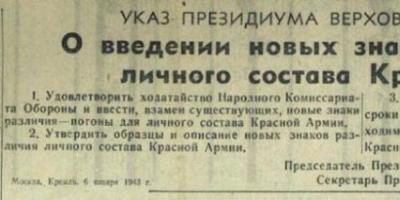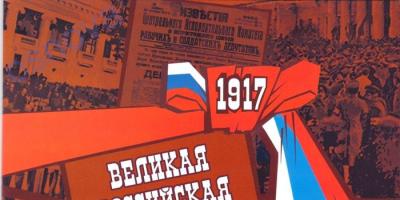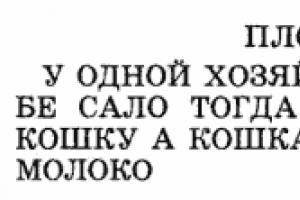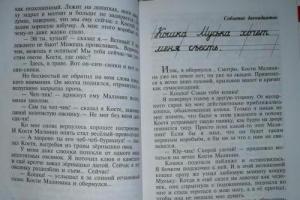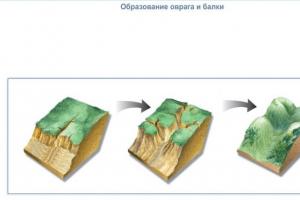On January 6, 1943, the decree of the Presidium of the Supreme Soviet of the USSR “On the introduction of new insignia for the personnel of the Red Army” was published. This document prescribed the introduction of new insignia to replace the existing ones - shoulder straps for Red Army personnel, as well as the approval of samples and descriptions of new insignia.
A quarter of a century after the revolution, the country's armed forces returned to their historical uniform.
The editorial material of the Krasnaya Zvezda newspaper dated January 7, 1943 emphasized that “today the Decree of the Presidium of the Supreme Soviet of the USSR on the introduction of new insignia - shoulder straps for the personnel of the Red Army is published. This event is an important event in the life of the army, because it is designed to further strengthen military discipline and military spirit.”  The central body of the People's Commissariat of Defense of the USSR reminded that “epaulettes with clear and clear outlines of insignia highlight the Soviet commander and the Red Army soldier, emphasize ranks, military specialty and make it possible to further strengthen military discipline and smartness.”
The central body of the People's Commissariat of Defense of the USSR reminded that “epaulettes with clear and clear outlines of insignia highlight the Soviet commander and the Red Army soldier, emphasize ranks, military specialty and make it possible to further strengthen military discipline and smartness.”
The main military newspaper of the country wrote on this day:
“We have first-class military equipment, and every day there will be more and more of it. The country sent its sons - loyal warriors - to the fronts, and the mighty strength of the Soviet soldier became famous throughout the world.
The people brought forward from among themselves cadres of commanders, cadres of military intelligentsia - bearers of everything heroic and noble that is in themselves. In fierce battles with the enemy, our soldiers and commanders raised high the honor of Russian weapons. The importance of a commander in an army is great. He has a primary role in battle, in all military life.
The role of the sovereign commander must be emphasized and strengthened in every possible way. This, in particular, will be facilitated by shoulder straps with their clear designations of service seniority.”
“Red Star” recalled that “epaulets were a traditional decoration of the valiant Russian army. We, the legitimate heirs of Russian military glory, take from the arsenal of our fathers and grandfathers all the best that contributed to raising military spirit and strengthening discipline. The introduction of shoulder straps once again confirms the glorious continuity of military traditions, which is so valuable for an army that loves its fatherland and values its native history. Shoulder straps are not only a detail of clothing. This is a sign of military dignity and military honor.”
The newspaper's editorial emphasized that “the content of the military uniform is determined by the fighting spirit of the troops, their glory, their moral strength, their traditions. By putting on shoulder straps - new signs of rank and military honor - we will feel even more clearly the duty that lies with the army defending its homeland from Nazi gangs. The people will give the army these badges of honor, while demanding that the army's honor be maintained on the battlefield."
The article also recalled: “The people have granted great rights to our officers, but at the same time they have imposed great responsibilities on them. To fight selflessly for the homeland, to always feel like an educator of the Red Army masses in everything, to always and in everything instill in the consciousness of your subordinates a feeling of love for the homeland, a correct understanding of your military duty - such is the duty of a Soviet officer.
The shoulder strap must constantly remind the commander of this duty. Wearing shoulder straps should instill in every serviceman a sense of pride that he has the honor of belonging to the valiant Red Army, a sense of pride both for himself and for our entire army.”
“Red Star” especially emphasized on this day: “We put on shoulder straps in the great and difficult time of the Patriotic War. Let us immortalize these signs of military distinction and military honor with new exploits for the glory of our fatherland and our heroic army!” 
Everyone according to their shoulder straps
Particularly interesting is the use of the words “officer” and “officership” in the editorial material of “Red Star”. For the first time since 1917, the word “officer” appeared in the May Day order of the People’s Commissar of Defense in 1942. This document noted that “the Red Army has become more organized and stronger, its officer cadres have become battle-hardened, and its generals have become more experienced and insightful.”However, the word “officer” was officially legalized in the second half of 1943.
Work on new uniforms and insignia began even before the war. According to some reports, the first samples of uniforms and shoulder straps were developed back in 1941.
In the study “Uniforms of the Red Army and the Wehrmacht” by Pavel Lipatov, it is indicated that “new insignia and uniforms began to be developed in mid-1942, taking as a basis the galloon and field shoulder straps of the Russian Imperial Army. They looked for old masters who had once woven gold patterned ribbons and revived a half-forgotten technology. Test samples were cut - lush and archaic double-breasted ceremonial frock coats with gold embroidery and thick epaulettes.”
Temporary technical specifications, which included a description of the emblems and insignia on shoulder straps, were published on December 10, 1942.
According to Pavel Lipatov, the new uniform was initially supposed to be introduced only in the guard, but the Supreme Commander-in-Chief, Comrade Stalin, decided to put shoulder straps on everyone.
The decree of the Presidium of the Supreme Soviet of the USSR emphasized that insignia - shoulder straps - serve to determine the military rank and affiliation of military personnel to one or another branch of the military (service). According to the assigned military rank, belonging to the branch of the military (service), insignia (stars, gaps, stripes) and emblems are placed on the shoulder straps, and on the everyday shoulder straps of junior commanders, enlisted personnel and military school cadets there are also stencils indicating the name of the military unit (connections).
As noted by researchers of domestic military uniforms, the shape of the shoulder straps of the Red Army was similar to the shoulder straps adopted in the Russian army before 1917. They were a strip with parallel long sides, the lower end of the shoulder strap was rectangular, and the upper end was cut at an obtuse angle. The shoulder straps of marshals and generals have the top of an obtuse angle cut parallel to the bottom edge.
For the first time in Russia, shoulder straps appeared under Peter the Great in 1696. But in those days they were not insignia and were intended to hold the strap of a cartridge or grenade bag on the shoulder of an ordinary soldier.
Then the infantrymen wore, respectively, only one shoulder strap on the left shoulder, the lower edge of which was sewn on, and the upper edge was fastened to the caftan and later to the uniform. In that era, officers, cavalrymen and artillerymen did not have shoulder straps. In other words, they were not present in those branches of the military in which there was no need for them.
Since 1762, shoulder straps have become insignia and determine whether a serviceman belongs to a particular regiment. Under Paul I, shoulder straps again performed only one function - holding the belt of the cartridge bag, but during the reign of Alexander I they again became insignia.
In the armed forces of Soviet Russia, shoulder straps were abolished on December 16, 1917.
In January 1943, at the height of the war, reform took place in the Red Army. Soviet soldiers and officers put on shoulder straps and changed ranks. Officers appeared in the army again. Like in the tsarist army.
"Strange" decree
On January 10, 1943, by order of NKO No. 24, it was announced that the Decree of the Presidium of the Supreme Soviet of the USSR dated January 6, 1943 “On the introduction of shoulder straps for Red Army personnel” was adopted. This document, and this decision itself - to undertake serious military reform in the midst of war - have, of course, their own history. This is what we want to tell you. Why did Stalin return the shoulder straps that served as a symbol of the White Army to the Red Army? How was this decree received? For what purpose was the military reform carried out?

Enemy propaganda reaction
It’s interesting how fascist propaganda greeted the return of shoulder straps. German greyhound writers immediately began to see in this step the weakness of Stalin, who made concessions out of fear. The Germans wrote that there are rumors that Stalin will change the name of the army to Russian.
They thus treated this as a forced and hasty decision, although the reality was completely different. The introduction of shoulder straps was part of the planned reform program of the Soviet Union.

How it happened
I’ll say right away: the idea has been brewing for a long time. Back in 1935, the rank of “Marshal of the Soviet Union” was introduced in the Red Army, and in 1940 the ranks of general and admiral were introduced. This can be considered an important milestone on the path to shoulder straps. By 1941, samples of the new uniform and shoulder straps were ready. In May 1942, the decree was approved by the Main Political Directorate of the Red Army. Temporary technical specifications (TTU) TC SIU KA No. 0725, which described the emblems and insignia (stars) on shoulder straps, were published on December 10, 1942. The Red Army needed a bright turning point victory. Stalingrad became such a victory. When it became clear that Paulus’s 6th Army would not have much time left, the project was approved by the Politburo of the Central Committee of the All-Union Communist Party (Bolsheviks) on October 23, 1942. According to the order, it was necessary to switch to shoulder straps within half a month - from February 1 to 15, 1943, however, even on the Kursk Bulge in July of this year, some pilots and tank crews, as can be seen in the photographs, wore not shoulder straps, but old buttonholes.

How the shoulder straps were changed
The introduction of shoulder straps was met with mixed reactions. It is known that, for example, Georgy Zhukov did not like shoulder straps. Many Soviet military leaders went through the Civil War - and their memory remembered the “golden chasers”. It must be said that, of course, Stalin’s shoulder straps were not a copy of the tsarist ones. Here there was a different system for designating ranks, as well as the ranks themselves. Instead of a second lieutenant, there was now a lieutenant, a staff captain became a captain, and instead of a captain, a major. On the shoulder straps of the army of the Russian Empire, ranks were indicated only by small stars. Stalin was the first to introduce big stars for senior officers. Field marshals in the tsarist army wore shoulder straps with two crossed batons on a zigzag braid. After the introduction of shoulder straps in 1943, the rank of Marshal of the Soviet Union began to be symbolized by a large star and the coat of arms of the USSR.

Officers
Order No. 1 of March 1, 1917 “On the democratization of the former army and navy” equalized the rights of soldiers and officers. Soon the very word “officer” began to be perceived as counter-revolutionary. Only in the May Day order of the People's Commissar of Defense in 1942 did it appear again. At the beginning of 1943, with the introduction of shoulder straps in the Red Army, the word officer officially fell out of favor. The commanders from the platoon commander to the brigade commander began to be called differently.

Why?
It is not entirely correct to consider the introduction of shoulder straps to be the personal initiative of the Supreme Commander-in-Chief. Shoulder straps were introduced by decision of the Presidium of the Supreme Soviet of the USSR. The Chairman of the Presidium was Mikhail Ivanovich Kalinin. This was a planned reform, preparation for it took almost ten years. There is a version that Stalin introduced shoulder straps almost out of nostalgia. In March 1918, Stalin acted as extraordinary commissar for the shipment of grain in Tsaritsyn and there he met the strange “red general” Andrei Evgenievich Snesarev, who refused on principle to remove the general’s shoulder straps and aiguillettes of the General Staff. Stalin remembered the proud officer. But this can hardly be called a historically based version. Most likely, the introduction of shoulder straps was caused by objective reasons:
1) Ideological (epaulettes have been an element of the uniform of the Russian army since the time of Peter the Great, and appealing to the names of the great Russian commanders was one of the methods of instilling patriotism)
2) Nominative. The war will end sooner or later. It was short-sighted to come to Berlin as “commanders” and “brigade commanders” - an approximate unification with the ranks of the allied countries was needed.
3) The victory in the Battle of Stalingrad turned the tide of the war. Changes in uniforms helped to invigorate the army. When the decree was adopted, articles about it immediately appeared in the newspapers. And they emphasize the symbolism of introducing shoulder straps precisely from the position of the inextricable connection of Russian victories.


"Strange" decree
On January 10, 1943, by order of NKO No. 24, it was announced that the Decree of the Presidium of the Supreme Soviet of the USSR of 01/06/1943 “On the introduction of shoulder straps for the personnel of the Red Army” was adopted. This document, and this decision itself - to undertake serious military reform in the midst of war - have, of course, their own history. This is what we want to tell you. Why did Stalin return the shoulder straps that served as a symbol of the White Army to the Red Army? How was this decree received? For what purpose was the military reform carried out?
Enemy propaganda reaction
It’s interesting how fascist propaganda greeted the return of shoulder straps. German greyhound writers immediately began to see in this step the weakness of Stalin, who made concessions out of fear. The Germans wrote that there are rumors that Stalin will change the name of the army to Russian.
They thus treated this as a forced and hasty decision, although the reality was completely different. The introduction of shoulder straps was part of the planned reform program of the Soviet Union.

How it happened Let's just say: the idea has been brewing for a long time. Back in 1935, the rank of “Marshal of the Soviet Union” was introduced in the Red Army, and in 1940 the ranks of general and admiral were introduced. This can be considered an important milestone on the path to shoulder straps. By 1941, samples of the new uniform and shoulder straps were ready. In May 1942, the decree was approved by the Main Political Directorate of the Red Army. Temporary technical specifications (TTU) TC SIU KA No. 0725, which described the emblems and insignia (stars) on shoulder straps, were published on December 10, 1942. The Red Army needed a bright turning point victory. Stalingrad became such a victory. When it became clear that Paulus’s 6th Army would not have much time left, the project was approved by the Politburo of the Central Committee of the All-Union Communist Party (Bolsheviks) on October 23, 1942. According to the order, it was necessary to switch to shoulder straps within half a month - from February 1 to 15, 1943, however, even on the Kursk Bulge in July of this year, some pilots and tank crews, as can be seen in the photographs, wore not shoulder straps, but old buttonholes.
 How the shoulder straps were changed
How the shoulder straps were changed
The introduction of shoulder straps was met with mixed reactions. It is known that, for example, Georgy Zhukov did not like shoulder straps. Many Soviet military leaders went through the Civil War - and their memory remembered the “golden chasers”. It must be said that, of course, Stalin’s shoulder straps were not a copy of the tsarist ones. Here there was a different system for designating ranks, as well as the ranks themselves. Instead of a second lieutenant, there was now a lieutenant, a staff captain became a captain, and instead of a captain, a major. On the shoulder straps of the army of the Russian Empire, ranks were indicated only by small stars. Stalin was the first to introduce big stars for senior officers. Field marshals in the tsarist army wore shoulder straps with two crossed batons on a zigzag braid. After the introduction of shoulder straps in 1943, the rank of Marshal of the Soviet Union began to be symbolized by a large star and the coat of arms of the USSR.
 Officers
Officers
Order No. 1 of March 1, 1917 “On the democratization of the former army and navy” equalized the rights of soldiers and officers. Soon the very word “officer” began to be perceived as counter-revolutionary. Only in the May Day order of the People's Commissar of Defense in 1942 did it appear again. At the beginning of 1943, with the introduction of shoulder straps in the Red Army, the word officer officially fell out of favor. The commanders from the platoon commander to the brigade commander began to be called differently.
Why did Stalin return the shoulder straps in 1943? WWII 1941-1945, history of the USSR
Why?
It is not entirely correct to consider the introduction of shoulder straps to be the personal initiative of the Supreme Commander-in-Chief. Shoulder straps were introduced by decision of the Presidium of the Supreme Soviet of the USSR. The Chairman of the Presidium was Mikhail Ivanovich Kalinin. This was a planned reform, preparation for it took almost ten years. There is a version that Stalin introduced shoulder straps almost out of nostalgia. In March 1918, Stalin acted as extraordinary commissar for the shipment of grain in Tsaritsyn and there he met the strange “red general” Andrei Evgenievich Snesarev, who refused on principle to remove the general’s shoulder straps and aiguillettes of the General Staff. Stalin remembered the proud officer. But this can hardly be called a historically based version. Most likely, the introduction of shoulder straps was caused by objective reasons: 1) Ideological (epaulets have been an element of the uniform of the Russian army since the time of Peter the Great, and appealing to the names of the great Russian commanders was one of the methods of instilling patriotism) 2) Nominative. The war will end sooner or later. It was short-sighted to come to Berlin as “commanders” and “brigade commanders” - an approximate unification with the ranks of the allied countries was needed. 3) The victory in the Battle of Stalingrad turned the tide of the war. Changes in uniforms helped to invigorate the army. When the decree was adopted, articles about it immediately appeared in the newspapers. And they emphasize the symbolism of introducing shoulder straps precisely from the position of the inextricable connection of Russian victories.
In January 1943, at the height of the war, reform took place in the Red Army. Soviet soldiers and officers put on shoulder straps and changed ranks. Officers appeared in the army again. Like in the tsarist army.
"Strange" decree"
On January 10, 1943, by order of NKO No. 24, it was announced that the Decree of the Presidium of the Supreme Soviet of the USSR of 01/06/1943 “On the introduction of shoulder straps for the personnel of the Red Army” was adopted. This document, and this decision itself - to undertake serious military reform in the midst of war - have, of course, their own history. This is what we want to tell you. Why did Stalin return the shoulder straps that served as a symbol of the White Army to the Red Army? How was this decree received? For what purpose was the military reform carried out? 
Enemy propaganda reaction
It’s interesting how fascist propaganda greeted the return of shoulder straps. German greyhound writers immediately began to see in this step the weakness of Stalin, who made concessions out of fear. The Germans wrote that there are rumors that Stalin will change the name of the army to Russian.
They thus treated this as a forced and hasty decision, although the reality was completely different. The introduction of shoulder straps was part of the planned reform program of the Soviet Union. 
How it happened
Let me just say: the idea has been brewing for a long time. Back in 1935, the rank of “Marshal of the Soviet Union” was introduced in the Red Army, and in 1940 the ranks of general and admiral were introduced. This can be considered an important milestone on the path to shoulder straps. By 1941, samples of the new uniform and shoulder straps were ready. In May 1942, the decree was approved by the Main Political Directorate of the Red Army. Temporary technical specifications (TTU) TC SIU KA No. 0725, which described the emblems and insignia (stars) on shoulder straps, were published on December 10, 1942. The Red Army needed a bright turning point victory. Stalingrad became such a victory. When it became clear that Paulus’s 6th Army would not have much time left, the project was approved by the Politburo of the Central Committee of the All-Union Communist Party (Bolsheviks) on October 23, 1942. According to the order, it was necessary to switch to shoulder straps within half a month - from February 1 to 15, 1943, however, even on the Kursk Bulge in July of this year, some pilots and tank crews, as can be seen in the photographs, wore not shoulder straps, but old buttonholes.

How the shoulder straps were changed 

Samples of shoulder straps for 1943.
The introduction of shoulder straps was met with mixed reactions. It is known that, for example, Georgy Zhukov did not like shoulder straps. Many Soviet military leaders went through the Civil War - and their memory remembered the “golden chasers”. It must be said that, of course, Stalin’s shoulder straps were not a copy of the tsarist ones. Here there was a different system for designating ranks, as well as the ranks themselves. Instead of a second lieutenant, there was now a lieutenant, a staff captain became a captain, and instead of a captain, a major. On the shoulder straps of the army of the Russian Empire, ranks were indicated only by small stars. Stalin was the first to introduce big stars for senior officers. Field marshals in the tsarist army wore shoulder straps with two crossed batons on a zigzag braid. After the introduction of shoulder straps in 1943, the rank of Marshal of the Soviet Union began to be symbolized by a large star and the coat of arms of the USSR.

Officers
Order No. 1 of March 1, 1917 “On the democratization of the former army and navy” equalized the rights of soldiers and officers. Soon the very word “officer” began to be perceived as counter-revolutionary. Only in the May Day order of the People's Commissar of Defense in 1942 did it appear again. At the beginning of 1943, with the introduction of shoulder straps in the Red Army, the word officer officially fell out of favor. The commanders from the platoon commander to the brigade commander began to be called differently.

Why?
It is not entirely correct to consider the introduction of shoulder straps to be the personal initiative of the Supreme Commander-in-Chief. Shoulder straps were introduced by decision of the Presidium of the Supreme Soviet of the USSR. The Chairman of the Presidium was Mikhail Ivanovich Kalinin. This was a planned reform, preparation for it took almost ten years. There is a version that Stalin introduced shoulder straps almost out of nostalgia. In March 1918, Stalin acted as extraordinary commissar for the shipment of grain in Tsaritsyn and there he met the strange “red general” Andrei Evgenievich Snesarev, who refused on principle to remove the general’s shoulder straps and aiguillettes of the General Staff. Stalin remembered the proud officer. But this can hardly be called a historically based version. Most likely, the introduction of shoulder straps was caused by objective reasons: 1) Ideological (epaulets have been an element of the uniform of the Russian army since the time of Peter the Great, and appealing to the names of the great Russian commanders was one of the methods of instilling patriotism) 2) Nominative. The war will end sooner or later. It was short-sighted to come to Berlin as “commanders” and “brigade commanders” - an approximate unification with the ranks of the allied countries was needed. 3) The victory in the Battle of Stalingrad turned the tide of the war. Changes in uniforms helped to invigorate the army. When the decree was adopted, articles about it immediately appeared in the newspapers. And they emphasize the symbolism of introducing shoulder straps precisely from the position of the inextricable connection of Russian victories.



